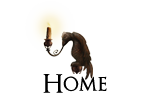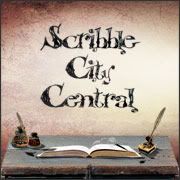I first encountered Mary Hoffman's David back in February this year, when Mary was kind enough to send me a very early proof. Last year I 'met' the man himself, in sculptural form, when I visited Florence. To me at that time he was, though utterly beautiful and mesmerising to look at, still only a cold, marble statue in 3D. Now, after reading Mary's marvellous book, he exists inside my head, 3D still, but reincarnated as a living, breathing, gloriously beddable Renaissance boy called Gabriele. To be honest with you, dear readers, I could go on about this book for hours. Not only is it a marvellously plotted story, taking known historical facts and interweaving them with nuggets of possibility into a seamless whole, but it also rekindled my long-buried interest in art history. It made me look at Michelangelo's sculpture in a whole new light, made me, as a writer, think as well about the hidden things behind all art--the myriad histories lost in time and waiting for a teller to give them life.
Mary herself is a magical teller and teaser-out of hidden histories. When I interviewed her for Mslexia magazine earlier in the year, she told me that David was the perfect story for her as a writer of historical fiction.
 |
| Mary and David |
"There were some incontrovertible facts, but absolutely nothing known for the crucial part of it. Nobody knows who the model was--or even if there was a model. That was the ideal scenario, because you've got your framework and the ability to bring historical characters alive--but then you can get in and tell your human story any way you damn well like!"
I can tell you that Mary's 'any way you damn well like' is pretty damn good as far as I'm concerned. I consider this to be her best book yet (and her previous books have all been fabulous). Buy it. Read it. Read it again. Trust me on this one!
And now, that's quite enough from me. I'm going to hand you over to Mary herself, who, this being the marvellously mythic Scribble City Central, has chosen to talk about Mars and Venus for the very last stop on her David Blog Tour. Welcome to SCC, Mary!
The David Blog Tour: Final Day - Mary Hoffman talks about Mars and Venus “Men are from Mars, Women from Venus” – so says the book title.
I think that’s pretty much nonsense. But certainly back in Renaissance Florence women didn’t go to war as soldiers. And you wouldn’t have found many men being hands-on dads either. In other words, the gender roles were pretty clearly divided. We are talking about over five hundred years ago, when women could not vote or hang on to their own property if they married.
Aristocratic women might have had some say in the ordering of their lives but marrying for dynastic reasons rather than love was common. Ordinary people of both sexes had hard lives in the Middle Ages and Renaissance and life expectancy was not all that long.
So the story of Gabriele and his many loves should be viewed in the context of that background. He poses as artist’s model for the painter Leone, as Hercules, Mars, Bacchus and Theseus – all mythological characters or legendary heroes. Like David, he is well suited to representing these figures, at least physically.
But he doesn’t feel heroic. He feel that he has betrayed Grazia by accepting her help and not loving her enough, the way Theseus betrayed Ariadne by allowing her to help him kill the Minotaur and then abandoning her.. But as he tells Leone, he has posed for Bacchus too – the god who rescues Ariadne so, in a sense, Grazia, who also poses for Leone sometimes, ends up with him anyway.
‘I think all of us are part Theseus, part Bacchus,’ [Leone] said.
‘And part Minotaur?’ I asked. ‘That’s what I’ve been thinking.’
‘You are very young, Gabriele,’ he said. ‘Don’t be too hard on yourself. We all make some mistakes as we are growing up.’
They are talking about the difficulty, as they see it, for men, to behave well in their love relationships with women. And it comes to them naturally to express this in terms of mythology, not just because of the subjects of Leone’s current paintings, but because everyone knew those stories then from the many representations of them in art.
And it is complicated for Gabriele by the fact that women – and men – throw themselves at him all the time! He means to behave well to all of them but it just too inexperienced and unsophisticated to handle the situations in which he finds himself. Thinking of himself as Mars – or any of the other classical figures – is a way of distancing himself from the actuality of relationship with a flesh and blood woman of his own time. And of telling himself that he is not the only male who has ever got himself into a pickle with females.
The god Mars has always struck me as rather stupid. And Venus was pretty dumb too! He did his he-man warlike stuff and she went around being beautiful. Apollo and Hermes (Mercury), Artemis and Athene (Diana and Minerva) are much more interesting, don’t you think?
Now if the book was “Men are from Mercury, Women from ...” But there is no other planet named after a goddess, is there? Perhaps that tells us something too.
Fascinating and illuminating stuff, Mary--with much mythic food for thought too. Thank you so much for visiting Scribble City Central.
www.bookmavenmary.blogspot.com



















4 comments:
Well, there is a very large asteroid circling the Sun in the asteroid belt, called Ceres. It's bigger then Pluto, which has just been demoted from planet-hood - so perhaps Ceres should be promoted?
And there's the moon, cold Diana - along with Uranus' moons Titania and Miranda: so at least we women have some representatives out in the solar system.
I thought 'David' was wonderful, Mary!
And Sedna, which put in a bid for planet-hood briefly.
Congratulations on completing a great, heroic blog tour, Mary!
Yes, indeed, congrats on your marathon blog tour! You now deserve a week in a blog-spa or blog-hotel...or even real ones!
And yes, Artemis and Pallas Athene are much nore interesting than Aphrodite. I'm attached to the Greek names, still.
Fascinating, such wonderful ideas.
Post a Comment